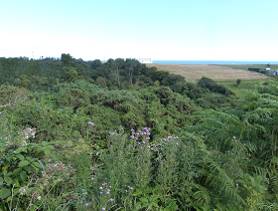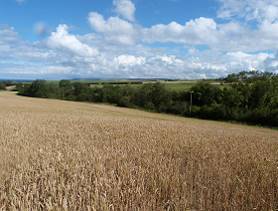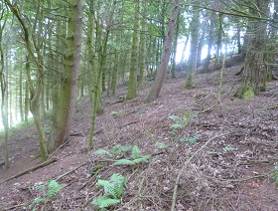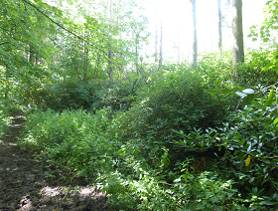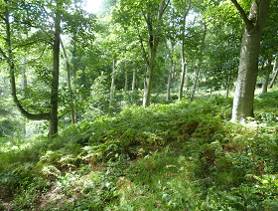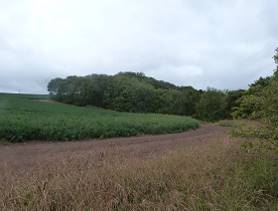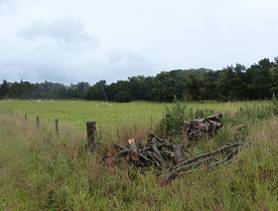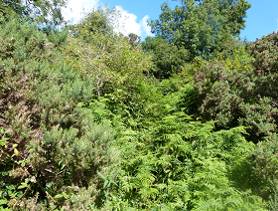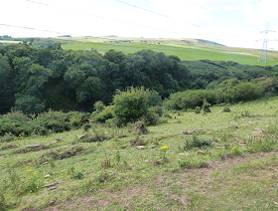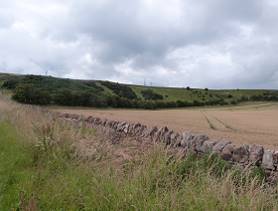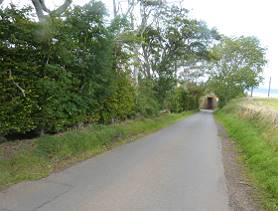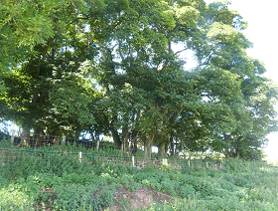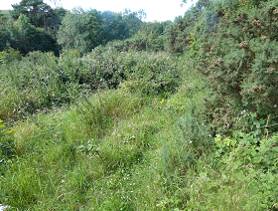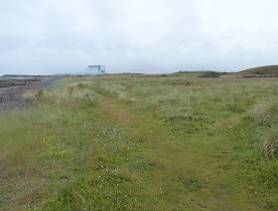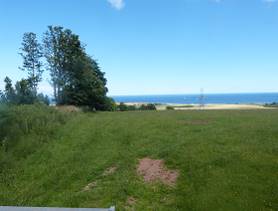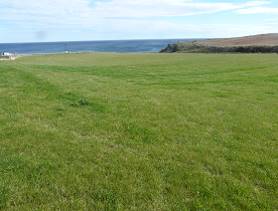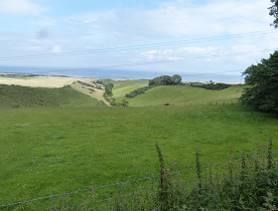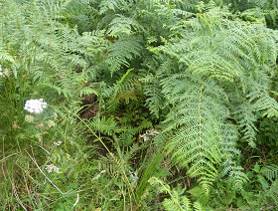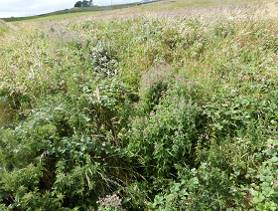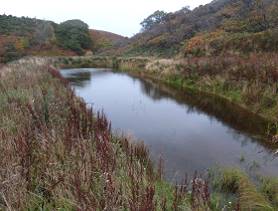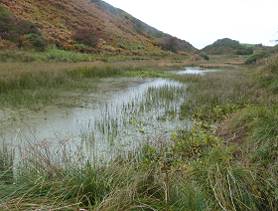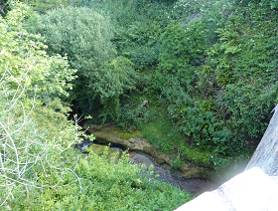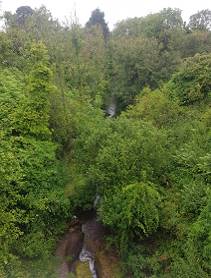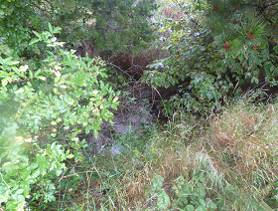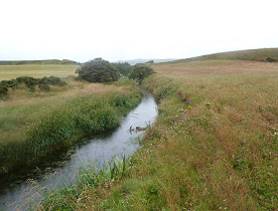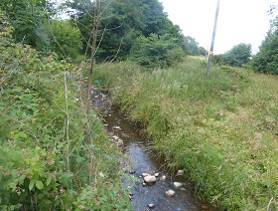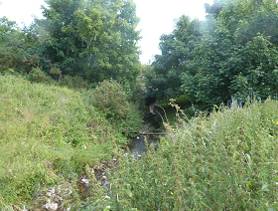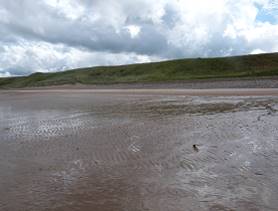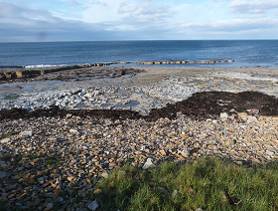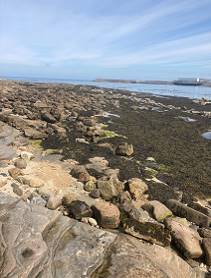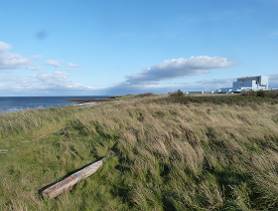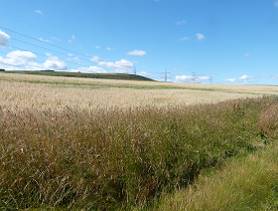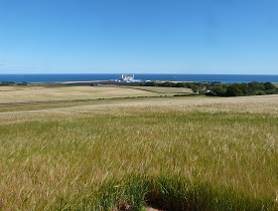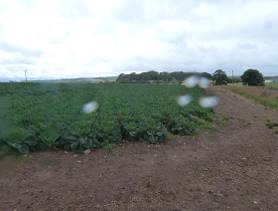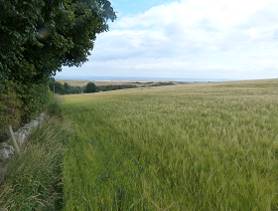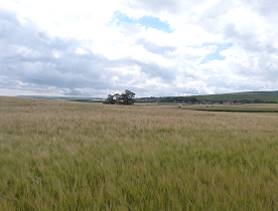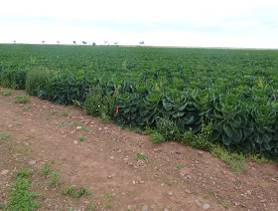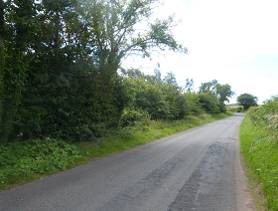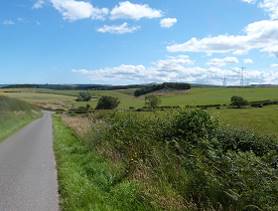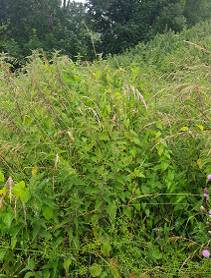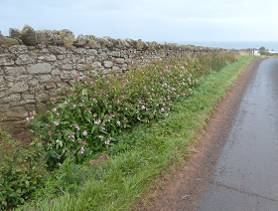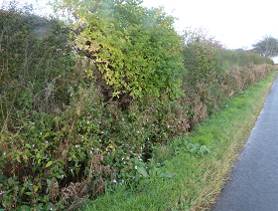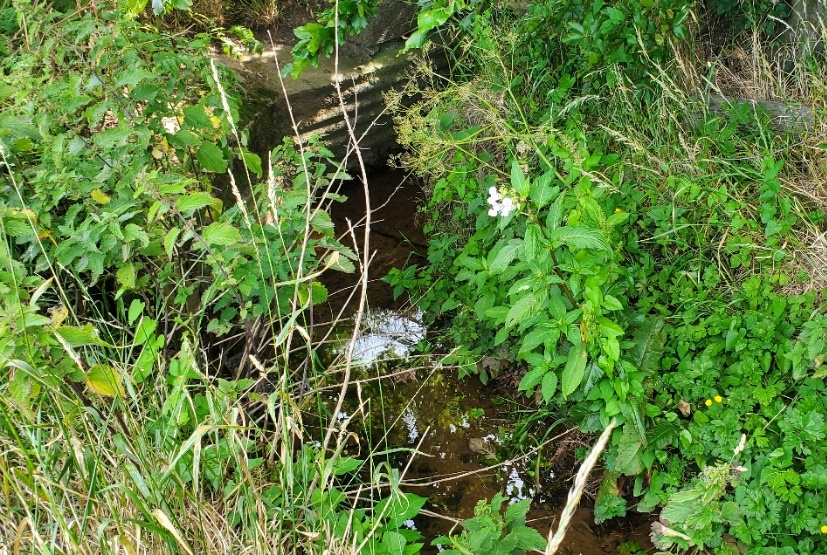Annex D: Target Notes
Table D1: Plants and habitats
Target Note | Grid Reference | Description |
|---|---|---|
1 | NT 72979 73322 |
Broadleaved, semi-natural woodland follows the course of the Braidwood Burn. Tree species recorded along the burn corridor included ash, sessile oak, beech, grey willow and alder with occasional Scots pine. Understorey vegetation included gorse, elder, hawthorn, bramble, butterbur, great wood-rush, male-fern and bracken. |
2 | NT 73502 73535 |
An area of dense broadleaved, semi-natural woodland follows the Thornton Burn northwards. Tree species recorded included ash and sycamore with a scrub understorey of hawthorn, dog-rose, honeysuckle and elder. Ground flora recorded included common hogweed, bramble, silverweed, red campion, lesser burdock, hedge woundwort, crossword, bush vetch, field forget-me-not, greater plantain, ribwort plantain, herb-robert, purple dead nettle, red clover, square-stalked St John’s-wort and ox-eye daisy. |
3 | NT 76035 72359 |
A strip of broadleaved, semi-natural woodland measuring follows the route of the Thurston Burn down to the sea within the central reaches of the Site. Dense vegetation provides limited access to the public but creates an ideal commuting and foraging corridor for a variety of species including bats, otter and badger. Common tree species found in this habitat include alder, ash, sycamore and pedunculate oak. Ground flora included common nettle, common valerian, creeping buttercup, lady’s bedstraw, rosebay willowherb, tormentil, ground elder, foxglove, maidenhair spleenwort, wood sedge, common hogweed. Buddleia was also recorded within the woodland. The surrounding habitat consists primarily of wheat crop being grown to the north of the woodland and grazing used by horses on the south of the woodland. |
4 | NT 73903 72809 | An area of broadleaved, semi-natural woodland borders the Site to the east of Thorntonloch Holdings. This is listed on the AWI as LEPO 2b. |
5 | NT 73411 75105 | An area of broadleaved, plantation woodland surrounds Orchard House near Skateraw, outwith the Site. |
6 | NT 74054 72649 | An area of coniferous, semi-natural woodland dominated by Scots pine lies to the west of Branxton Farm Cottage, outwith the Site. This is listed on the AWI as LEPO 2b. |
7 | NT 73227 74900 | An area of coniferous plantation dominated by Scots pine borders the A1 trunk road to the south of Skateraw and extends north and south along a drainage ditch. |
8 | NT 73813 72315 |
Large area of mixed semi-natural woodland located within the south-eastern reaches of the study area. Tree species recorded included beech, ash, sessile oak and sycamore with occasional sweet chestnut. The woodland stand directly to the south of the arable field was found to have high percentage of Scots pine and Sitka spruce in these areas the ground flora was more sparse. The understorey vegetation included wild garlic, great wood-rush, bluebell, common nettle, ground elder, bracken and creeping buttercup. Along the woodland margins species include meadow foxtail, soft brome, common bent, common yarrow, meadow crane’s bill, purple dead nettle, lesser spearwort and field scabious. The well-drained slopes within the woodland are considered to provide badgers with good sett building habitat. |
9 | NT 75506 72081 |
The edge of Gallow’s Law, a mixed, semi-natural woodland in the south-east corner of the study area, outwith the Site. The habitat is considered suitable for badger and bats due to the dense vegetation understorey and the variety of tree species that would provide good foraging potential. The common tree species in this habitat include Scots pine, sycamore, rowan and silver birch with an extensive understorey of rhododendron. Ground flora species recorded included lady-fern, male-fern, broad-leaved dock, ground elder, wild garlic, wood forget-me-not, germander speedwell, maidenhair spleenwort, foxglove, great wood-rush and common nettle. |
10 | NT 73729 75438 |
Small area of mixed, semi-natural woodland located to the north-east of Skateraw along the Skateraw Dean which connects to the Dry Burn to the west. Tree species recorded included sycamore, Scots pine, rowan and ash with an understorey of elder and hawthorn. The ground flora was dominated by bracken and common nettle. Bat boxes were sited on a mature sycamore within the stand. |
11 | NT 73331 75312 |
Shelterbelt of mixed, plantation woodland located within 100 m of a farm shed to the west of Skateraw. The treeline follows the field boundary in an L-shape, bordering fields used for sheep grazing and crops. Tree species recorded in this area include sycamore, Scots pine, silver birch, beech, elder and ash. This tree line is a potential commuting route for species such as bats and badger to the wider environment. |
12 | NT 73733 73277 |
Areas of dense/continuous scrub located at the edge of the roadside extending into an adjacent area of broadleaved, semi-natural woodland, becoming the understorey and in this case following the Thornton Burn. Dominant species found in these areas include gorse, bramble and elder with ground flora species of tall fescue, tufted hair-grass, false brome, common nettle, false nettle, cleavers, honeysuckle and thistle species. |
13 | NT 73631 73307 |
Large sections of dense gorse scrub found at the slope of Brunt Hill leading south towards Braidwood Burn. Other plant species recorded included common bent, perennial rye-grass, sweet vernal grass, ragwort, meadow-grasses and cock’s-foot. |
14 | NT 73049 73584 |
Dense scrub habitat along the slope of improved grassland bordering an arable field with scattered immature trees providing a commuting route for species including badgers and bats. Species recorded included hawthorn, gorse and regenerating sycamore encompassed by a stone wall field boundary. |
15 | NT 73377 75525 |
Scattered scrub running adjacent to Dry Burn. Species include bramble, immature willow, elder, gorse and hawthorn. Understorey species included greater burdock, common thistle, false oat-grass and meadow-grasses. |
16 | NT 75293 73439 |
Scattered ash within beech hedge with elder understorey located along the roadside and drainage ditch. Understorey vegetation included broad-leaved dock, lesser plantain, common nettle, common nipplewort, lesser spearwort, creeping thistle, cleavers, common yarrow, field forget-me-not, devil’s-bit scabious, Himalayan balsam and rosebay willowherb. This habitat feature provides a good commuting and foraging route for bats however no potential roost features suitable for bats were observed. |
17 | NT 74517 72839 |
Area of broadleaved scattered trees including ash, sycamore and beech. No features identified with bat roosting potential however these trees provide a potential foraging and commuting route to further areas of beech and hawthorn to the south. |
18 | NT 73321 75894 |
Semi-improved grassland found at the north-west of the Study Area, lying between coastal grassland and arable land as it follows the North Sea coastline west to east towards Torness power station. Species recorded included false oat-grass, cock’s-foot, wavy hair-grass and meadow fescue with occasional ragwort, sheep’s-bit, devil’s-bit scabious, common knapweed and tormentil. |
19 | NT 73780 73245 |
Small area of semi-improved grassland along access track close to Thornton Burn running south of the bridge crossing and the arable fields. Grass species including cock’s-foot, Yorkshire-fog and false oat-grass recorded. Other plant species recorded in this area included butterbur, broom, common figwort, common knapweed, common nipplewort and herb Robert. |
20 | NT 73890 73284 |
Vegetation typically found at the edge of the road in overgrown lay-bys and as margins between hedgerow and wooded areas as semi-improved grassland. Common grass species identified include cock’s-foot, false oat-grass and meadow fescue with other plants including dog-rose, ragwort, ribwort plantain, dock and bramble. |
21 | NT 73292 76025 |
Semi-improved grassland meadow to north-west of Skateraw harbour. Species recorded included crested dog’s-tail, timothy, creeping buttercup, perennial rye-grass, ragwort, yellow saxifrage, sea campion, gorse, broad-leaved dock, meadow crane’s-bill and cow parsley. |
22 | NT 73940 72782 |
Improved grassland currently used for grazing with species including perennial rye-grass, false oatgrass, cock’s-foot grass and meadow fescue and bordered by row of immature ash trees. |
23 | NT 75366 73970 |
Improved grassland field of perennial rye-grass, cock’s-foot and Yorkshire fog with a high percentage of white clover. |
24 | NT 74168 72728 |
Improved grassland fields of perennial rye-grass with white clover, Yorkshire fog and common meadow-grass also recorded. Used for grazing and bordering the Branxton Burn. |
25 | NT 73859 72252 |
Area of continuous bracken within woodland. Other species recorded in this area included bramble and common nettle. |
26 | NT 75423 73921 |
The end of the Branxton Burn watercourse at the eastern boundary of Site leading down to sea is heavily overgrown by tall ruderal species including rosebay willowherb. Other species recorded in this area included bramble, common comfrey and foxglove. Vegetation was dense and at least c.2 m deep either side of the burn in this area. |
27 | NT 73269 72680 |
Pond 1 – Waterbody fed by Ogle Burn found c.315 m south of the Site boundary, within the 500 m survey area. The pond is c.150 m² with a low level of macrophyte cover, good surrounding habitat and no water fowl or fish observed during the survey. The HSI score for great crested newt potential is 0.71 (Good) |
28 | NT 72935 72795 |
Pond 2 – Kames Well found c.300 m west of the Site boundary, within the 500 m survey area. The pond is c.200 m |
29 | NT 73671 75405 |
Small pond/pool fed by the Skateraw burn underneath the canopy of woodland and within the Site. The pond is c.50 m² with no macrophyte cover and grassy vegetative habitat immediately surrounding the pond. The HSI score for GCN potential is 0.46 (Poor). |
30 | NT 72428 75367 | Small waterbody within Viridor site, 177 m west of the Site – no access. Review of aerial photograph suggests this is likely a settlement pond, situated in rough grassland surrounded by scattered scrub. |
31 | NT 72408 75382 | Small waterbody within Viridor site, 235 m west of the Site – no access. Review of aerial photograph suggests this is likely a settlement pond, situated in rough grassland surrounded by scattered scrub. |
32 | NT 72272 75560 | Large water body within Viridor site, 370 m west of the Site – no access. Review of aerial photograph suggests this waterbody is over 3.7 hectares in area. Likely to be suboptimal due to presence of fish and or water fowl. |
33 | NT 73918 73302 |
Bridge crossing over valley overlooking Thornton Burn watercourse. Slope gradient alongside watercourse is c.40 degree. Tree species recorded along the riparian corridor included beech, alder, hazel, ash with an understorey of ivy, lady-fern, great wood-rush and hard fern. Depth of watercourse in this area was shallow c.10-30 cm but fast flowing. Channel width c.4 m and burn width c.1 m in this section. |
34 | NT 73403 75439 |
Skateraw watercourse covered by a dense tree canopy including Scots pine, Leyland cypress, sycamore and ash. The burn was estimated to be 10 cm deep and 3m across at time of survey with a stone base and bankside vegetation including holly, elder and bramble. Other plants identified include rhododendron, hawthorn and rosebay willowherb. |
35 | NT 73444 75670 |
Inlet of the watercourse where Dry Burn ends at sea. Stoney bank at edges of burn before banks are dominated by grass species and dense scrub. |
36 | NT 75263 74223 |
Mouth of Thornton Burn watercourse. Estimated as 4 m across, 40 cm deep and with a sand and rock base. Bordering vegetation includes grey willow, goat willow, common comfrey, oxeye daisy, marram grass, broad-leaved dock, Yorkshire-fog and thistle species. |
37 | NT 71708 75064 |
Dry Burn to the west of A1 trunk road at west side of study area passing under road culvert. The stone base was estimated as 3m wide with an average channel depth of 20 cm. |
38 | NT 75478 73871 |
Coastland intertidal beachhead of sand with no vegetation leading up to dune grassland. |
39 | NT 73837 75818 |
Boulders and rocks above and below the high tide mark can be found to the north of Torness Point. Size of rock along the beach measured c.10-20 cm in diameter. Species recorded included biting stonecrop, bladder wrack, spiral wrack, oarweed and sea lettuce. |
40 | NT 75403 73993 |
Shingle above high tide mark between coastal grassland and intertidal mud/sand. |
41 | NT 73822 75793 |
Coastal grassland recorded along the edge of the rocky intertidal habitat. Within the sparser areas of marram grass and sea bindweed other species such as bird’s-foot trefoil, lady’s bedstraw and wild thyme were recorded. |
42 | NT 73538 73415 |
Arable field of cereal with marginal vegetation including common burdock, crested dog’s-tail, timothy, common nettle, white clover, ox-eye daisy and field poppy. Mature hawthorn hedge border the field. |
43 | NT 73149 73468 |
Arable crop fields within western reaches of study area, outwith the Site. Barley was commonly grown in these areas and field boundaries were often defined by stone walls approximately 1.5 m high. |
44 | NT 73543 75402 |
Edge of arable crop field, observed to be growing brussel sprouts and surrounded by a stone wall boundary leading to houses. |
45 | NT 71646 74788 |
Edge of western survey area is predominantly arable wheat fields bordered by semi-mature broadleaved woodland and mature, defunct and intact, hawthorn hedgerows. |
46 | NT 73123 75160 |
Arable land used for growing Brussels sprouts at north of Site. |
47 | NT 74932 72690 |
Species-poor intact hedge dominated by hawthorn. Other species recorded in understorey included bindweed, bramble, bird’s-foot trefoil, dock, butterbur, thistle species and dandelion. |
48 | NT 74621 72244 |
Species-poor defunct hawthorn hedgerow with scattered trees including willow and ash. |
49 | NT 75592 72453 |
Stone wall c.1 m at side of road with species-poor hedge on east. Understory species include bramble and common grasses such as cock’s-foot and Yorkshire fog. On the west side of the road there is a high managed hedge of sycamore and hawthorn with an understorey of ivy, nettle and bramble. |
50 | NT 74241 74110 |
Invasive non-native species (INNS) Japanese knotweed extending for approximately 50 m² alongside Thornton Burn. |
51 | NT 75041 72992 |
Himalayan balsam extending c.50 m along roadside ditch next to stone wall. |
52 | NT 75248 73330 |
Himalayan balsam extending c.100 m along roadside ditch next to hedge and scrub. |
53 | NT 74441 72916 |
Sand Martin burrows along sandy bank of burn. |
54 | NT 76053 73150 |
Coastal cliff with Palustriella commutata-dominated spring vegetation. Smaller areas of similar bryophyte spring communities occur along the cliff c. 50 m north and south of this location. The vegetation conforms to National Vegetation Classification (NVC) (Rodwell, 1991) M37 Palustriella commutata-Festuca rubra spring. The bryophyte Palustriella commutata (formerly Cratoneuron commutatum) and red fescue are abundant, with other species including colt’s-foot, sea plantain, marsh thistle, ragwort, marsh marigold and marsh horsetail. Water drips through the community and areas of bare mud are present, suggesting local slippage. |
55 | NT 73210 75209 |
|
Annex E: Species List
Table E1: Common and Scientific Names
Scientific Name | |
|---|---|
Forbs |
|
Bird’s-foot trefoil | Lotus corniculatus |
Biting stonecrop | Sedum acre |
Bladder campion | Silene vulgaris |
Bluebell | Hyacinthoides non-scripta |
Broad-leaved dock | Rumex obtuifolius |
Broom | Cytisus scoparius |
Bush vetch | Vicia sepium |
Butterbur | Petasites hybridus |
Cleavers | Galium aparine |
Colt’s-foot | Tussilago farfara |
Common burdock | Arctium minus |
Common comfrey | Symphytum officinale |
Common figwort | Scrophularia nodosa |
Common hogweed | Heracleum sphondylium |
Common knapweed | Centaurea nigra |
Common nettle | Urtica dioica |
Common nipplewort | Lapsana communis |
Common thistle | Cirsium vulgare |
Common valerian | Valeriana officialis |
Common yarrow | Achillea millefolium |
Cow parsley | Anthriscus sylvestris |
Creeping buttercup | Ranunculus repens |
Crosswort | Cruciata laevipes |
Devil’s-bit scabious | Succisa pratensis |
False nettle | Boehmeria cylindrical |
Field forget-me-not | Myosotis arvensis |
Field poppy | Papaver rhoeas |
Field scabious | Knautia arvensis |
Foxglove | Digitalis purpurea |
Germander speedwell | Veronica chamaedrys |
Globe thistle | Echinops bannaticus |
Gorse | Ulex europaeus |
Greater burdock | Articum lappa |
Greater burnet-saxifrage | Pimpinella major |
Greater plantain | Plantago major |
Ground elder | Aegopodium podagraria |
Hedge bindweed | Convolvulus arvensis |
Hedge mustard | Sisymbrium officinale |
Hedge woundwort | Stachys sylvatica |
Herb-robert | Geranium robertianum |
Lady’s bedstraw | Galium verum |
Large thyme | Thymus pulegioides |
Lesser burdock | Arctium minus |
Lesser spearwort | Ranunculus flammula |
Maidenhair spleenwort | Asplenium trichomanes |
Marsh marigold | Caltha palustris |
Marsh thistle | Cirsium palustre |
Meadow crane’s-bill | Geraium pratense |
Navelwort | Umbilicus rupestris |
Oxeye daisy | Leucanthemum vulgare |
Pineappleweed | Matricaria discoidea |
Purple deadnettle | Lamium purpureum |
Ragwort | Jacobaea vulgaris |
Red campion | Silene dioica |
Red clover | Trifolium pratensis |
Ribwort plantain | Plantago lanceolata |
Rosebay willowherb | Chamerion angustifolium |
Scentless mayweed | Tripleurospermum inodorum |
Sea bindweed | Calystegia soldanella |
Sea campion | Silene uniflora |
Sea plantain | Plantago maritima |
Sea sandwort | Honckenya peploides |
Sheep’s-bit | Jasione montana |
Silverweed | Argentina ansrina |
Smooth hawks-beard | Crepis capillaris |
Spearwort | Ranunculus flammula |
Spleenwort | Asplenium trichomanes |
Square-stalked St. John’s wort | Hypericum tetrapterum |
Sunspurge | Euphorbia helioscopia |
Teasel | Dipsacus fullonum |
Thrift | Armeria maritima |
Tormentil | Potentilla erecta |
Water mint | Mentha aquatica |
White clover | Trifolium repens |
White deadnettle | Lamium album |
Wild garlic | Allium ursinum |
Wild thyme | Thymus polytrichus |
Wood forget-me-not | Myosotis sylvatica |
Yellow saxifrage | Saxifraga aizoides |
Yellow toadflax | Linaria vulgaris |
Grasses |
|
Annual meadow grass | Poa annua |
Cock’s-foot | Dactylis glomerata |
Common bent | Agrostis capillaris |
Crested dog’s-tail | Cynosurus cristatus |
Crested-hair grass | Koeleria macrantha |
False oat-grass | Arrhenatherum elatius |
Hairy oat-grass | Arrhenatherum elatius |
Marram | Ammophila |
Meadow fescue | Festuca pratensis |
Meadow foxtail | Alopecurus pratensis |
Perennial rye-grass | Lolium perenne |
Red fescue | Festuca rubra |
Sheep’s fescue | Festuca ovina |
Smooth meadow-grass | Poa pratensis |
Soft brome | Bromus hordeaceus |
Sweet vernal-grass | Anthoxanthum odoratum |
Tall fescue | Festuca arundinacea |
Timothy | Phleum pratense |
Tufted hair-grass | Deschampia cespitosa |
Wall barley | Hordeum murinum |
Wavy hair-grass | Deschampsia flexuosa |
Yorkshire-fog | Holcus lanatus |
Sedges and rushes |
|
Field woodrush | Luzula campestris |
Greater woodrush | Luzula slyvatica |
Sand sedge | Carex arenaria |
Wood sedge | Carex sylvatica |
Seaweed | |
Sea lettuce | Ulva lactua |
Oarweed | Laminaria digitata |
Spiral wrack | Fucus spiralis |
Bladder wrack | Fucus vesiculosus |
Ferns and Horsetails | |
Bracken | Pteridun aquilinum |
Broad-buckler fern | Dryopteris dilatata |
Hard fern | Blechnum spicant |
Lady-fern | Athyrium filix-femina |
Male-fern | Dryopteris filix-mas |
Marsh horsetail | Equisetum palustre |
Bryophytes | |
A bryophyte | Palustriella commutata |
Trees, shrub and scrub: |
|
Ash | Fraxinus excelsior |
Bramble | Rubus fruticosus agg. |
Common ivy | Hedera helix |
Dog-rose | Rosa canina |
Elder | Sambucus nigra |
Field rose | Rosa arvensis |
Goat willow | Salix caprea |
Gooseberry | Ribes uva-crispa |
Grey willow | Salix cinerea |
Hawthorn | Crataegus monogyna |
Hazel | Corylus avellana |
Holly | Ilex aguilfolium |
Honeysuckle | Lonicera periclymenum |
Leyland cypress | Cupressus × leylandii |
Pedunculate oak | Quercus robur |
Privet | Ligustrum vulgare |
Raspberry | Rubus idaeus |
Rowan | Sorbus acuparia |
Scots pine | Pinus sylvatica |
Scotch laburnum | Laburnum alpinum |
Sessile oak | Quercus petrea |
Silver birch | Betula pendula |
Sitka Spruce | Picea sitchensis |
Sweet chestnut | Castanea sativa |
Sycamore | Acer pseudoplatanus |
Wild cherry | Prunus avium |
Introduced Shrub (Non-Native) |
|
Buddleja | Buddleja davidii |
Rhododendron | Rhododendron indicum |
Invasive Non Native Species |
|
Himalayan balsam | Impatiens glandulifera |
Japanese knotweed | Fallopia japonica |

